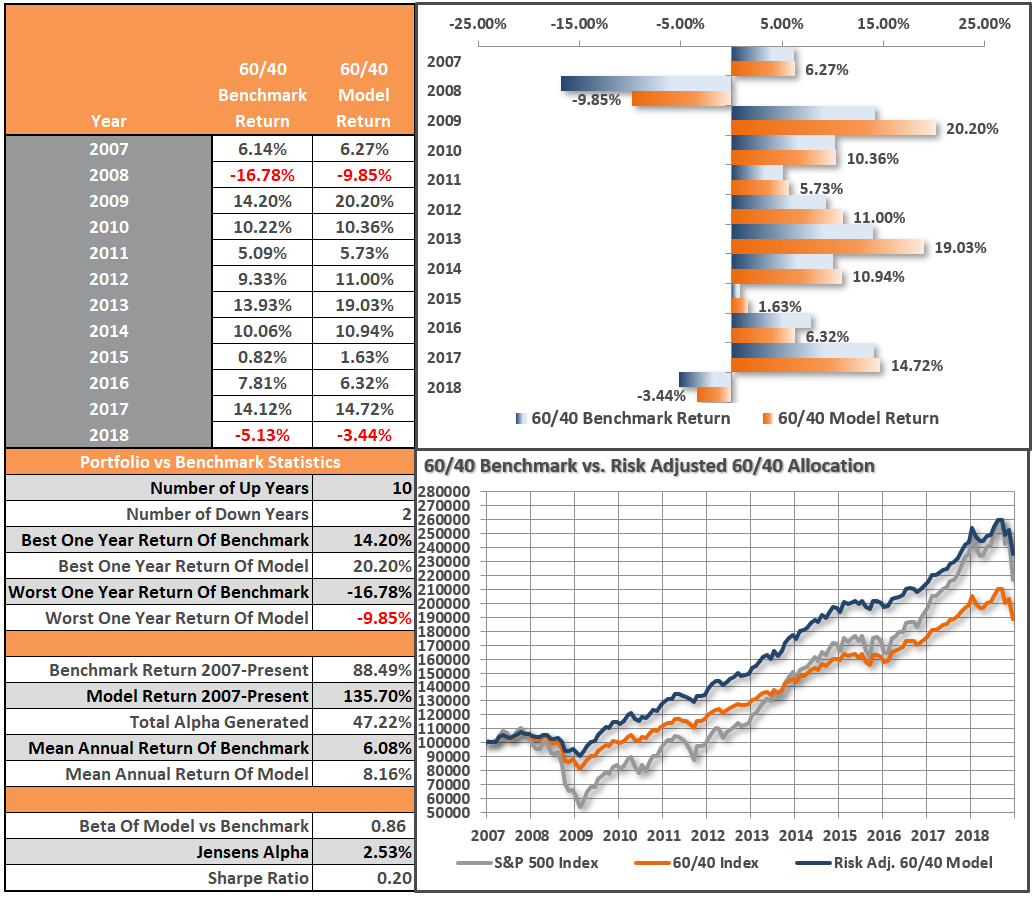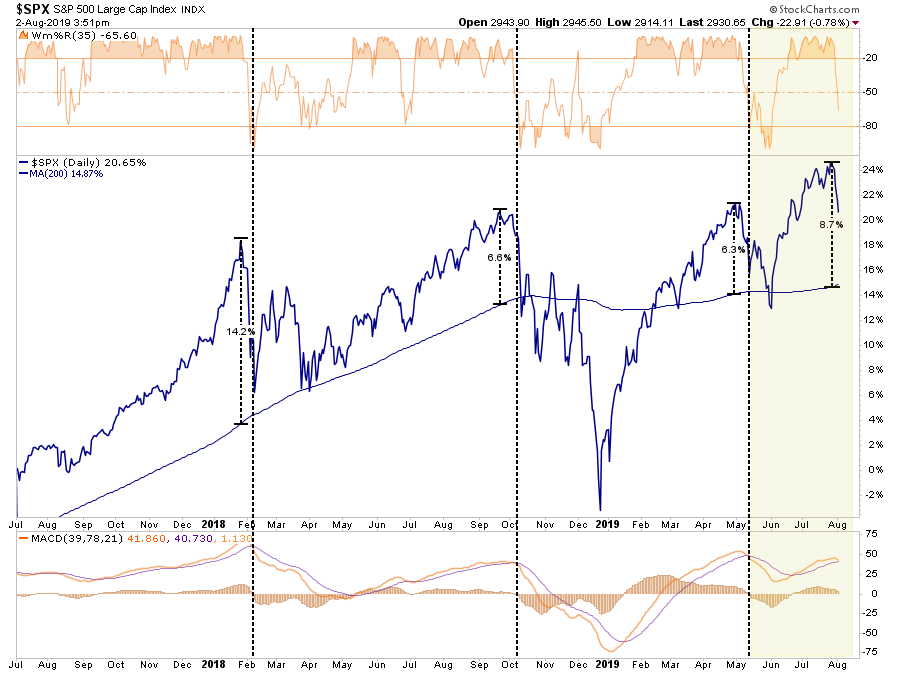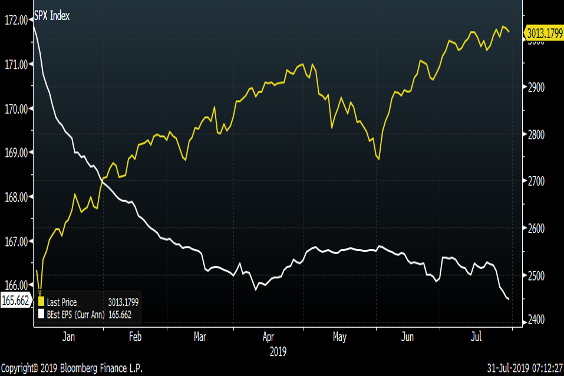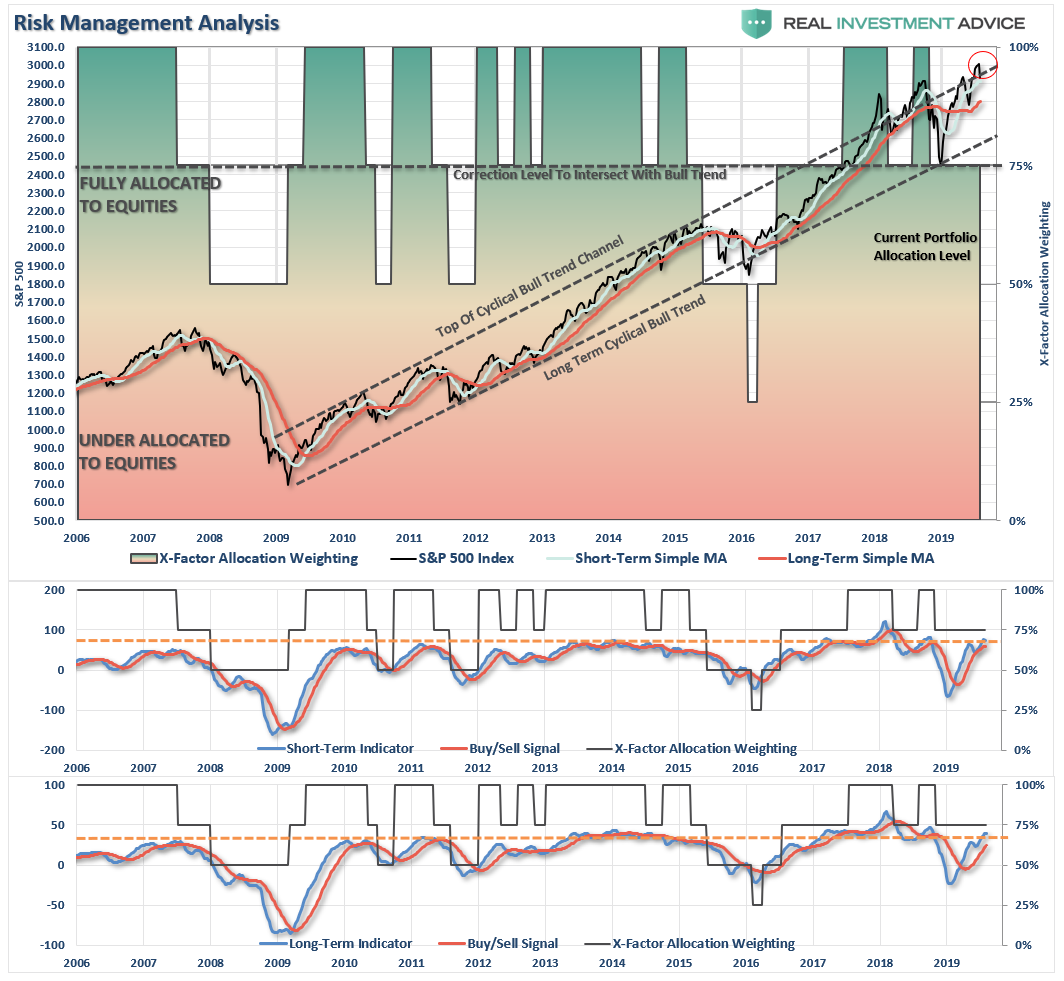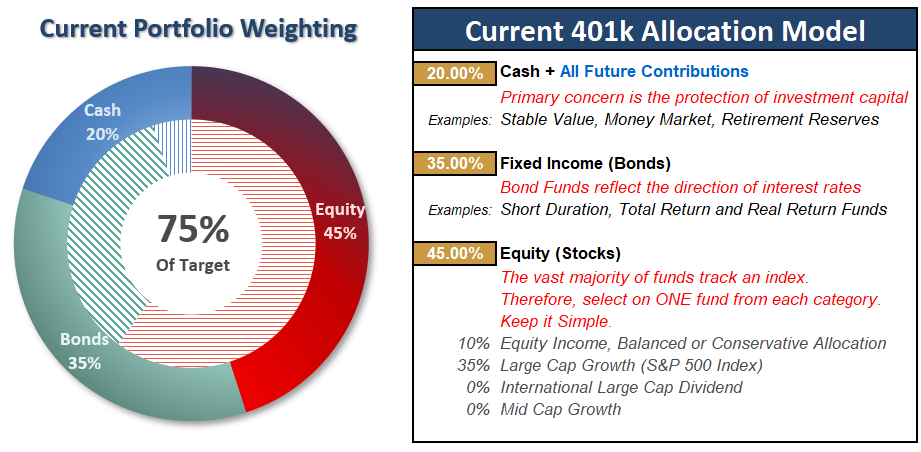Market Review & Update
I am on vacation this week, but there is so much going on I couldn’t miss penning a few quick views. I have also solicited some help from some friends.
First, let’s review where we are from last week.
“While the market is rallying in anticipation of more Central Bank easing, especially following the recent announcement by the ECB of lower rates and more QE, the markets are momentarily detached from weaker earnings growth, weaker economic growth, and a variety of other market-related risks.
However, in the very short-term, the market is grossly extended and in need of some correction action to return the market to a more normal state. As shown below, while the market is on a near-term “buy signal” (lower panel) the overbought condition, and near 9% extension above the 200-dma, suggests a pullback is in order.”
Chart Updated Through Friday
We had also warned previously the current extension of the market, combined with overbought conditions, was due for a reversal. That reversal has indeed begun, and short-term sell signals have been triggered.
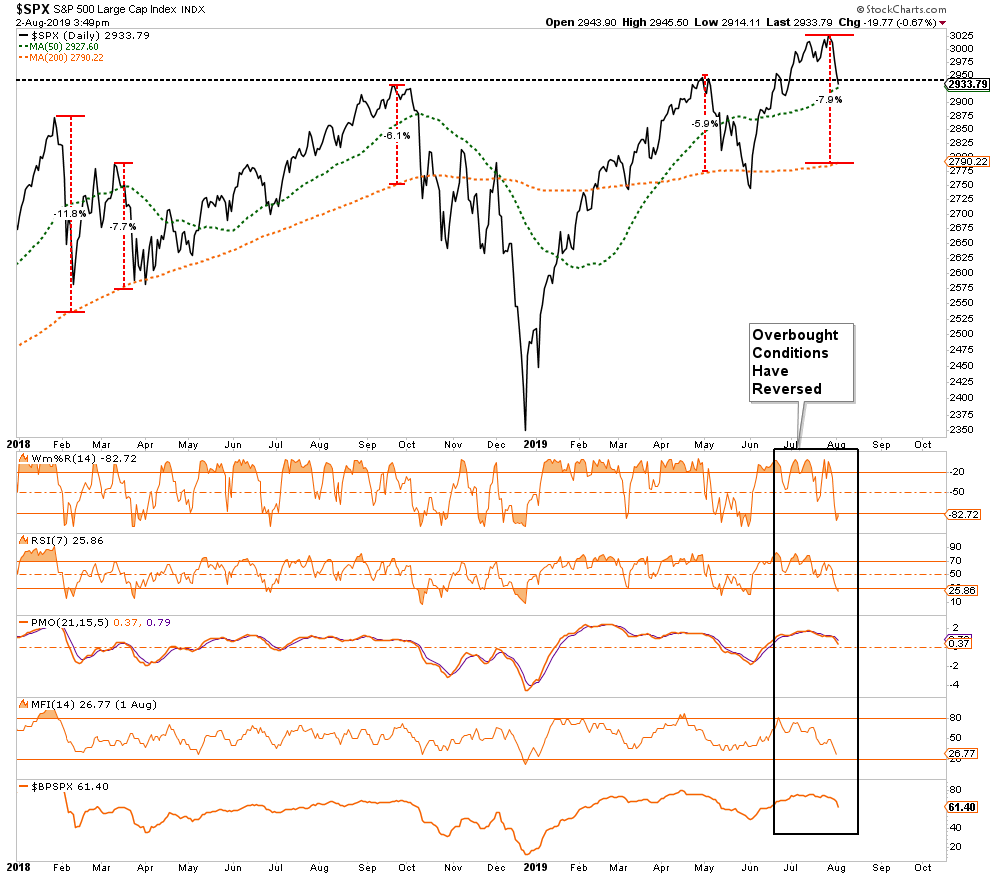
“As we have noted over the last few weeks, the very tight trading range combined with negative divergences also does not historically suggest continued bullish runs higher without some type of corrective action first.”
Chart Updated Through Friday
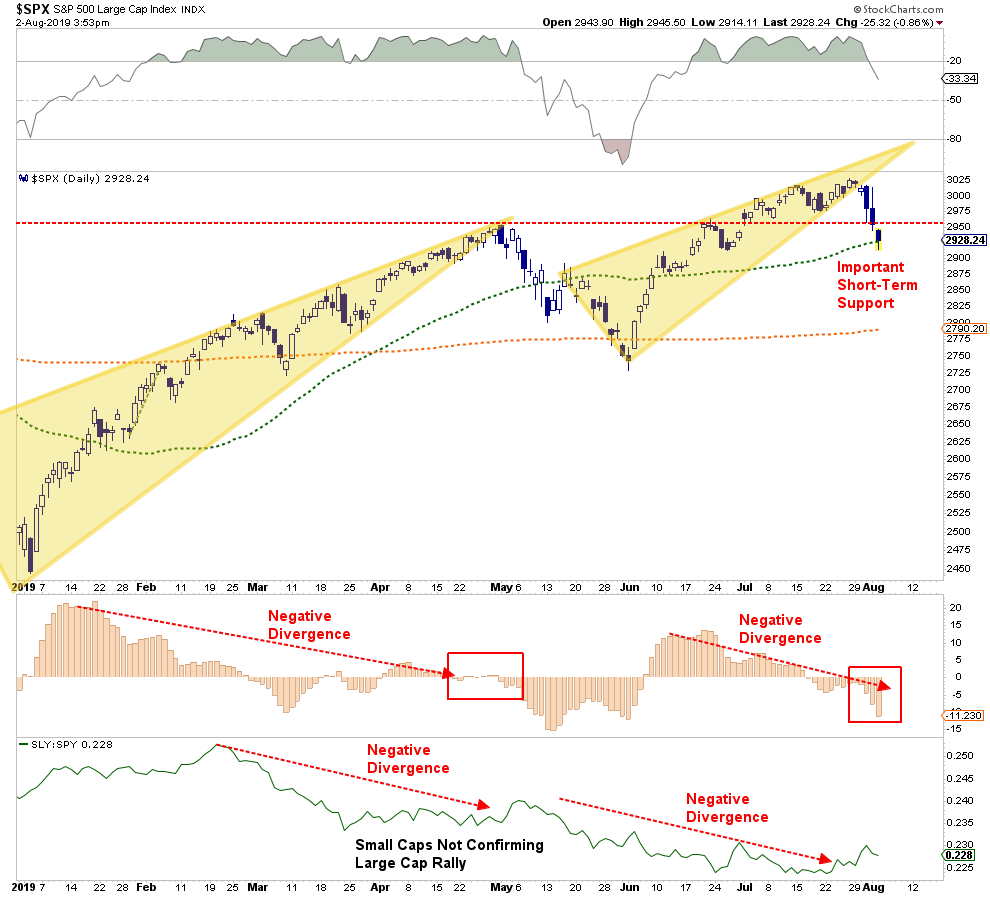
This past week, a disappointing cut by the Fed, and increased tariffs on China from the White House, provided the catalysts needed for a very quick market rout.
Again, this is something we discussed over the last couple of weeks with our RIAPRO subscribers previously (30-Day Free Trial). The analysis led us to previously trimming our long positions slightly, and increasing our cash holdings, heading into the Fed announcement.
July 22nd Portfolio Update: This morning action was taken and we took profits on 10% of 11 of our equity holdings. All of these positions had gains in excess of 20% since January 1st.
Risk Is Now Elevated
While the current correction has now traced back to initial support at the 50-dma, as shown above, our models still suggest a potential for a continued correction over the next two months.
I loved this note from my friend Victor Adair at Polar Futures Group:
“The market had a lot to digest this past week and thinner-than-normal mid-summer conditions may have exaggerated the moves…but it still feels like there’s a ‘sea-change’ happening here that may be foreshadowing bigger moves to come.
I wrapped up my July 19 TD Notes with, ‘It feels like the stage is set for volatility to jump… I think a lot of recent positioning might have to be reversed.’
This week saw reversals everywhere, and reversals of reversals! Markets had not correctly ‘priced-in’ the Fed and hadn’t anticipated Tariff Man taking another swipe at China. (Retaliation coming?) So…markets has to price-in a ‘new reality’ or, more accurately a ‘new imagining of what is to come.’ The common feature across markets was that volatility surged higher. Fear happens fast.”
Fear does happen fast.
Importantly, while the markets did hold support on Friday, there was enough selling last week to generate are very short-term oversold condition. Markets don’t move in a straight line.
From that view, it is likely we will see a bounce next week following 5-days of fairly brutal selling. Use that bounce to take profits and rebalance risk in portfolios for now.
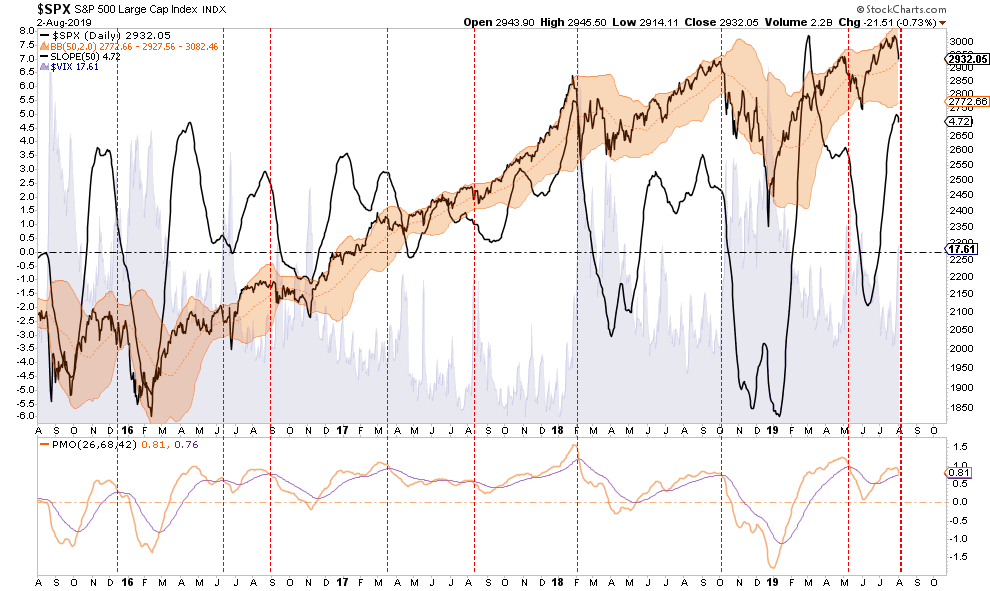
As the markets move past the Fed, and begin to focus on weaker earnings and economic growth, the backdrop becomes more problematic for the bullish case. We suggested last week, the Fed signaled their “rate cut” may be “one and done” for the time being. This could well put them behind the curve, given the ongoing collapse in many of the economic indicators. As noted by Mike Shedlock this week:
“Look at new export orders, deliveries that are expanding while the backlog of orders is now deep in contraction. Manufacturers cannot use backlogs to keep production up with new orders barely above break even. The details suggest production will go into contraction next month. Markit PMI Lowest Since September 2009″
More importantly, the backdrop to equities has skewed to levels which have historically denoted elevated risks for investors. As noted by BofA’s Michael Harnett (via Zerohedge)
- Fed cut makes it 729 global central bank cuts since Lehman bankruptcy. (You shouldn’t be cutting rates if economic growth was strong and supportive of higher asset values)
- Soaring US consumer confidence at highest level vs. plunging German business confidence since Q4’98…when Fed cut rates “mid-cycle” igniting bubble of ’99.
- EM equities at lowest level vs. US equities since 2003…China weak, US$ strong.
- Wall St (US private sector financial assets) now 5.5x the size of Main St (US GDP)… between 1950 & 2000 the norm was 2.5-3.5x…Wall Street is now “too big to fail”.
- Global debt now 3.2x the size of global GDP, an all-time high.
- Fresh China tariffs in Sept would raise average US tariff on total imports to 5.6% from 4.5%, highest since 1972…was 1.5% before Trump.
- US companies spent $114 on buybacks for every $100 of capex in past 2 years… between 1998 & 2017 they spent $60 for every $100 of capex.
- Inflows to bond funds ($278bn) rising at a record pace in 2019.
- Past 10 years $4.1tn into passive investment funds vs. $1.5tn out of active funds.
- Just 6% of MSCI ACWI stocks account for 53% of YTD global equity return.
Here is the overlooked issue. It is taking sustained lower rates, and more debt, to just maintain the system currently. The problem for the Fed, and the markets, is that rate cuts, at this late stage of the economic cycle, will have a muted effect due to a broken transmission system. As noted by Austan Goolsby via NYT:
“It’s not just that the Fed has a ‘short runway,’ rates are already so low that it is impossible to cut them four or five percentage points in the face of a recession, as the Fed has done in the past. The real problem is that recent experience and new economic research suggest that rate cuts in general may have a more modest impact on the economy now than they usually do.
The worry, arising from some important new research, is that the benefits of Fed rate cuts in today’s environment may be substantially overrated.”
His point is critically important.
Lower rates have less impact on the “economy,” when the monetary transmission system is weak. This is evident from the fact that surging asset prices have left 90% of the population behind in terms of higher levels of prosperity.
This also is why tax cuts failed to work as intended. After a decade of low rates, and excess liquidity, the ability to “pull-forward” demand has become limited. As Austan notes:
“A similar dynamic probably helps explain why the 2017 corporate tax cut has had such an underwhelming impact on companies’ capital investment. Fundamentally, there wasn’t much pent-up demand for investment after years of low rates, accelerated depreciation, “temporary” investment expensing and other stimulus. That lack of pent-up demand also means that cutting interest rates now is unlikely to entice businesses to invest much more.
So it’s a twofold problem: The Fed has less room to cut rates, and the benefit from cutting them is smaller than usual. We should be wary of vesting too much importance on Fed moves.”
Then you have a President “hellbent” on making this worse by Tweeting out yesterday:
“Trade talks are continuing, and during the talks the U.S. will start, on September 1st, putting a small additional Tariff of 10% on the remaining 300 Billion Dollars of goods and products coming from China into our Country. This does not include the 250 Billion Dollars already Tariffed at 25%.
As I have stated repeatedly in the past, this action was likely.
- A Trade deal wasn’t reached and China will continue to refuse to give in to demands for economic reform. Additional tariffs are coming by the end of the summer.
- Existing tariffs, which were just ratcheted up at the beginning of June, have not been fully recognized in the economy as of yet. More “pain” is coming by the end of the summer.
- While the markets think that Trump has the ‘upper hand,’ it is China for now. They can hold out to economic pressures far longer than Trump, as Xi is not facing re-election. China knows this.
While the latest move by President Trump could well be an attempt to force the Fed to lower rates further, this is a dangerous game of brinkmanship. The Fed’s rate cuts, and changes in monetary policy, take between nine and twelve months to filter into the economy. However, Trumps “tariffs,” have an almost immediate impact on market and corporate psychology.
While Trump may well get his rate cuts, as noted above, it will likely have a much more muted effect than what is currently believed. With the additional pressure on corporate profits, in an already deteriorating environment, this could develop into a potentially worse outcome for investors.
Low Yields Don’t Support Higher Valuations
I have seen too much commentary as of late suggesting that since the Fed is lowering rates, then valuations should be higher.
My friend Doug Kass penned an excellent piece on this last week.
“Price is what you pay, value is what you get.”- Warren Buffett
“The stock market is not expensive if you believe two percent fed funds and two percent ten-year governments… In the last fifty years when the market multiple averaged 15x and the ten year government was 6.5% and is now 2.00% the fed funds was five and is currently two. The multiple is ten percent higher today than historically but rates are a third of historical levels.”- Lee Cooperman,
I argued that comparing equities to bonds – which almost everyone recognizes to be an overvalued asset class (especially in an intermediate term sense) – represents a slippery slope to support current and elevated stock valuations. I went on to suggest to Lee that stocks don’t deserve a higher multiple for lower interest rates if the reason for lower rates is slower growth.
Again, second-level thinking might be called for. Lee went on to point out (with the assistance of his partner and my old pal Steve Einhorn) that 2Q 2019 S&P earnings, previously expected to decline by about 2%-3%, should now show a small increase. Steve and Lee are forecasting 2019 S&P earnings of $168/share. Here I would point out that we started the year with consensus S&P EPS above $172/share – so Lee’s $168/share estimate is lower, during a time in which S&P prices rose by over +20%.
As noted by Peter Boockvar (in the chart of the S&P 500 Index and the consensus 2019 earnings estimates) and as I noted in my column – price-earnings multiples have advanced in 2019 (from 14.5x to 17.5x) without ANY growth in S&P earnings.
In fact, the 2019 S&P EPS estimates have been continually downgraded throughout the first seven months of this year (I remain at around $160/share, and that’s where I was since November, 2018).
S&P 500 price in yellow, S&P earnings estimate in white ($165.60, a new low for the year)
Here is the point:
“Low rates can justify higher valuations IF everything else is growing ‘organically.’ When valuations are high due to low rates being used for leverage to make up for slow growth, then higher valuations are not justified.”
The Fed is Pushing on a String – and a meaningful market decline might lie ahead once investors realize that the cost and availability of capital is not what is holding back the global economy.
For now, the best course of action remains a “wait and see” approach. We continue to carry an overweight position in cash, fixed income, and rate hedges, and an underweight exposure to risk equities.
I will be back next week.
If you need help or have questions, we are always glad to help. Just email me.
See you next week.
Market & Sector Analysis
Data Analysis Of The Market & Sectors For Traders
If you are NOT an RIA PRO subscriber you are missing the most important part of each weeks’ newsletter.
- Sector & Market Performance Analysis
- Portfolio Recommendations
- What We Are Doing With Our Clients.
Try it today for FREE for 30-days.
THE REAL 401k PLAN MANAGER
A Conservative Strategy For Long-Term Investors
There are 4-steps to allocation changes based on 25% reduction increments. As noted in the chart above a 100% allocation level is equal to 60% stocks. I never advocate being 100% out of the market as it is far too difficult to reverse course when the market changes from a negative to a positive trend. Emotions keep us from taking the correct action.
Trump Is Making This Really Tough
As noted over the last two weeks,
“The market breakout was straining the deviation from the long-term moving average. That continues to be the case this week. Our conviction of a short-term correction to rebalance portfolios into continues to be high. We believe that correction will occur over the next two months to reverse the rather extreme overbought condition currently. A 3 to 5% correction in August or September is likely.”
As noted in the main body of this week’s missive, a less than anticipated rate cut, and outlook, by the Fed tripped up participants. Then Trump deciding to add additional tariffs on China, in order to force the Fed to cut rates, roiled stocks even more.
Stock sold off for the entirety of last week, so expect a rally early next week to sell into. Take some actions if you have not already as the next two months could bumpy. The correction is likely not complete yet.
- If you are overweight equities – Hold current positions but remain aware of the risk. Take some profits and rebalance risk to some degree if you have not already.
- If you are underweight equities or at target – rebalance risks, look to increase holdings in domestic equities opportunistically if the markets can hold support at the May highs next week.
As noted last week:
“With the markets back to extremely overbought conditions, patience will likely be rewarded.”
Now you know why we are patient.
If you need help after reading the alert; do not hesitate to contact me.
401k Plan Manager Beta Is Live
We have rolled out a very early beta launch to our RIA PRO subscribers
Be part of our “Break It Early Testing Associate” group by using CODE: 401
The code will give you access to the entire site during the BETA testing process, so not only will you get to help us work out the bugs on the 401k plan manager, you can submit your comments about the rest of the site as well.
We have several things currently in development we will be adding to the manager, but we need to start finding the “bugs” in the plan so far.
We are currently covering more than 10,000 mutual funds and have now added all of our Equity and ETF coverage as well. You will be able to compare your portfolio to our live model, see changes live, receive live alerts to model changes, and much more.
We are building models specific to company plans. So, if you would like to see your company plan included specifically, send me the following:
- Name of the company
- Plan Sponsor
- A print out of your plan choices. (Fund Symbol and Fund Name)
I have gotten quite a few plans, so keep sending them and I will include as many as we can.
If you would like to offer our service to your employees at a deeply discounted corporate rate, please contact me.
Current 401-k Allocation Model
The 401k plan allocation plan below follows the K.I.S.S. principle. By keeping the allocation extremely simplified it allows for better control of the allocation and a closer tracking to the benchmark objective over time. (If you want to make it more complicated you can, however, statistics show that simply adding more funds does not increase performance to any great degree.)
Model performance is based on a two-asset model of stocks and bonds relative to the weighting changes made each week in the newsletter. This is strictly for informational and educational purposes only and should not be relied upon for any reason. Past performance is not a guarantee of future results. Use at your own risk and peril. 